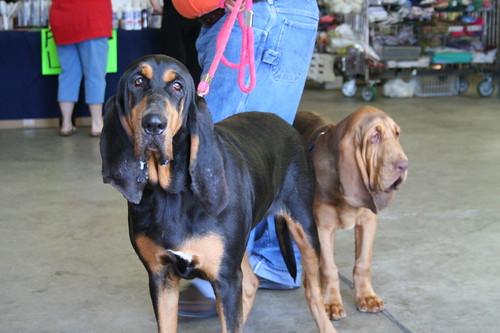Bloodhound
History of the breed
A bloodhound (also known as the St. Hubert hound) is a large breed of dog bred for the specific purpose of tracking human beings. Consequently, it is often used by authorities to track escaped prisoners or missing persons. It is a scenthound, famed for its ability to follow a scent hours or even days old, over long distances. Combining a keen sense of smell with a tenaciously strong tracking instinct, bloodhounds have proven their worth as the archetypal trailing dog.
The bloodhound was, according to legend, first bred ca. 1000 AD by monks at the St. Hubert Monastery in Belgium. Undoubtedly, its origins do reside in France, home of many of the modern hound breeds. Bloodhounds excellent tracking skills were drawn on in breeding other scenthounds, such as the English Foxhound, American Foxhound, Coonhound, Swiss Jura Hound, Bavarian Mountain Hound, and many others.
Appearance of the breed
Bloodhounds weigh from 80 to 110 lb, although some individuals can weigh as much as 160lbs and stand 23 to 27 inches high at the withers. The acceptable colors for bloodhounds are black and tan, liver and tan, or red. In the Middle Ages, they also occurred in other solid colors, including white (known as the Talbot hound). The colors appear in other breeds descended from the early bloodhounds, however. Bloodhounds possess an unusually large skeletal structure; most of their weight is concentrated in their bones, which are very thick for their length. The coat is typical for a scenthound: hard, and composed of fur alone, with no admixture of hair.
Temperament of the breed
The Bloodhound is a gentle dog who is nonetheless tireless in following a scent. Because of its strong tracking instinct, it can be willful and somewhat difficult to obedience train. However, with the proper amount of time, effort, and how well you treat it, this can be achieved easily.
Affectionate, gentle, and even-tempered describes a bloodhound makes an excellent family pet but, like any large breed, require supervision when around small children because they will knock them over with their bulk. Bloodhounds are also characterized by a stubborn "whats-in-it-for-me?" temperament, a likely cause (in conjunction with their size and propensity for excessive drooling) for the high rate of bloodhounds given up for adoption once full-grown in comparison with other breeds.
The bloodhound's physical characteristics account for its superlative ability to follow a scent trail left several days in the past. Humans constantly shed skin cells, as newer cells replace older ones. Under optimal conditions, a bloodhound can detect as few as one or two skin cells. Odors are identified by scent receptors in a dog's nasal chambers; the larger the chambers, the greater the dog's ability to detect skin cells. The bloodhound's nasal chambers are larger than those of most other breeds. The large, long pendent ears serve to prevent wind from scattering nearby skin cells while the dog's nose is on the ground; the folds of wrinkled flesh under the lips and neck--called the shawl--serve to catch stray scent particles in the air or on a nearby branch as the bloodhound is scenting, reinforcing the scent in the dog's memory and nose.
The misconception persists that bloodhounds are employed in packs. While this is sometimes the case in England, in North America, bloodhounds are used as solitary trackers. Bloodhounds on a trail are usually silent, and do not give voice as other scent hounds.
Health Concerns of the breed
Compared to other purebred dogs, bloodhounds have an unusually high rate of gastrointestinal ailments, with gastric dilatation volvulus (GDV, or "bloat") being the most common type of gastrointestinal problem. They also have an unusually high incidence of eye, skin, and ear ailments. Eyes, ears, and skin should be inspected frequently for signs of developing problems. Owners should be especially aware of the signs of GDV, which is both the most common illness and the leading cause of death of bloodhounds.
Bloodhounds median longevity is 6.75 years, which makes them one of the shortest-lived of dog breeds. A leading cause of death is gastric dilatation volvulus (GDV = "bloat" or "torsion").
Gastric dilatation volvulus
Bloodhound owners should take special note of the extremely high incidence of GDV (Gastric dilatation volvulus) in this breed. Excess gas trapped in the dog's stomach causes "bloat." Twisting of the stomach (volvulus or "torsion") causes, or is caused by, excess gas. Symptoms include restlessness, inability to get comfortable, pacing, or retching without being able to bring up anything. The dog's abdomen may be visibly swollen but dogs can bloat or torsion without visible swelling. GDV is a dire emergency condition. If you suspect a dog is bloating, you should not wait to see if he improves. A dog with GDV requires immediate veterinary care. The dog's survival usually depends on whether the owner can get him to the vet in time. It is a good idea for a bloodhound owner to know the route to the nearest 24 hour emergency clinic in advance, so time is not wasted looking for directions.








